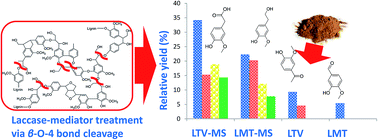当前位置:
X-MOL 学术
›
Sustain. Energy Fuels
›
论文详情
Our official English website, www.x-mol.net, welcomes your
feedback! (Note: you will need to create a separate account there.)
Laccase–natural mediator systems for “green” synthesis of phenolic monomers from alkali lignin
Sustainable Energy & Fuels ( IF 5.0 ) Pub Date : 2017-07-10 00:00:00 , DOI: 10.1039/c7se00209b Bin Yao 1, 2, 3, 4 , Praveen Kolla 2, 3, 4, 5 , Ranjit Koodali 4, 6, 7, 8 , Selvaratn Balaranjan 4, 6, 7, 8 , Sunav Shrestha 4, 6, 7, 8 , Alevtina Smirnova 1, 2, 3, 4, 5
Sustainable Energy & Fuels ( IF 5.0 ) Pub Date : 2017-07-10 00:00:00 , DOI: 10.1039/c7se00209b Bin Yao 1, 2, 3, 4 , Praveen Kolla 2, 3, 4, 5 , Ranjit Koodali 4, 6, 7, 8 , Selvaratn Balaranjan 4, 6, 7, 8 , Sunav Shrestha 4, 6, 7, 8 , Alevtina Smirnova 1, 2, 3, 4, 5
Affiliation

|
Being a major byproduct of pulp and paper industry, lignin has attracted attention as a source of high-value organic chemicals, e.g. phenolic monomers that can be produced by lignin enzymatic treatment. In this study, the alkali lignin was treated by the laccase of Trametes versicolor (LTV) and laccase of Myceliophthora thermophila (LMT) laccases with or without natural mediator methyl syringate (MS). After treatment, the lignin pore volume has been increased by 66% and 167% for LTV–MS and LMT–MS systems, respectively. The mass balance analysis confirms that the 5 wt% LTV–5 wt% MS (LTV–MS (5, 5)) system produces 40 wt% more of the organic compounds than the 5 wt% LMT–5 wt% MS (LMT–MS (5, 5)) system, thus demonstrating higher efficiency of the LTV–MS toward lignin decomposition. The gas chromatography-mass spectroscopy (GCMS) analysis indicates that after lignin treatment with LTV–MS more phenolic products are produced in comparison to LMT–MS, among them 3-hydroxy-4-methoxy-benzaldehyde has the highest relative yield of 34.7 and 23.8 wt% for LTV–MS and LMT–MS systems, respectively. Pyrolysis-GCMS (pyr-GCMS) of the solid-state lignin residue after its treatment with laccase–mediator system (LMS) confirms significant enrichment of the solid-state lignin surface with phenolic groups. The total organic carbon (TOC) analysis shows that 38.76 mg L−1 of the organic carbon is produced by the LTV–MS (5, 5) system. A decrease in the decomposition temperature by 4 °C for the lignin sample treated by the LTV–MS (in comparison to LMT–MS) obtained from the thermogravimetric (TGA) analysis confirms superior performance of the LTV–MS vs. LMT–MS system. A comparative study of the enzymatically active systems with two laccases and a natural mediator applied to the alkali lignin has been performed. This study highlights an important role of the laccase in combination with a mediator methyl syringate for production of high-value phenolic monomers.
中文翻译:

漆酶-天然介质系统,用于从碱性木质素“绿色”合成酚类单体
作为纸浆和造纸工业的主要副产品,木质素作为高价值有机化学品的来源已引起关注,例如,可以通过木质素酶处理生产的酚类单体。在这项研究中,碱木质素分别用Trametes versicolor(LTV)漆酶和嗜热毁丝霉(Myceliophthora thermophila)漆酶处理。(LMT)带有或不带有天然介质丁香酸酯(MS)的漆酶。经过处理后,LTV-MS和LMT-MS系统的木质素孔体积分别增加了66%和167%。质量平衡分析证实,与5 wt%LMT-5 wt%MS(LMT-MS)相比,5 wt%LTV-5 wt%MS(LTV-MS(5,5))系统产生的有机化合物多40 wt% MS(5,5))系统,因此证明了LTV-MS对木质素分解的更高效率。气相色谱-质谱(GCMS)分析表明,与LMT-MS相比,用LTV-MS木质素处理后产生的酚类产物更多,其中3-羟基-4-甲氧基-苯甲醛的相对产率最高,为34.7。 LTV-MS和LMT-MS系统分别为23.8 wt%。热解-GCMS漆酶-介体系统(LMS)处理后的固态木质素残留物(-GCMS)证实了固态木质素表面明显带有酚基。总有机碳(TOC)分析表明,LTV-MS(5,5)系统产生了38.76 mg L -1的有机碳。用于从热获得由LTV-MS(相比于LMT-MS)处理的木质素样品中的分解温度的降低通过4℃(TGA)分析证实了LTV-MS的性能优越与LMT-MS系统。已经对具有两个漆酶和应用于天然木质素的天然介体的酶促活性体系进行了比较研究。这项研究强调了漆酶与丁香酸甲酯介质的结合在生产高价值酚类单体中的重要作用。
更新日期:2017-08-23
中文翻译:

漆酶-天然介质系统,用于从碱性木质素“绿色”合成酚类单体
作为纸浆和造纸工业的主要副产品,木质素作为高价值有机化学品的来源已引起关注,例如,可以通过木质素酶处理生产的酚类单体。在这项研究中,碱木质素分别用Trametes versicolor(LTV)漆酶和嗜热毁丝霉(Myceliophthora thermophila)漆酶处理。(LMT)带有或不带有天然介质丁香酸酯(MS)的漆酶。经过处理后,LTV-MS和LMT-MS系统的木质素孔体积分别增加了66%和167%。质量平衡分析证实,与5 wt%LMT-5 wt%MS(LMT-MS)相比,5 wt%LTV-5 wt%MS(LTV-MS(5,5))系统产生的有机化合物多40 wt% MS(5,5))系统,因此证明了LTV-MS对木质素分解的更高效率。气相色谱-质谱(GCMS)分析表明,与LMT-MS相比,用LTV-MS木质素处理后产生的酚类产物更多,其中3-羟基-4-甲氧基-苯甲醛的相对产率最高,为34.7。 LTV-MS和LMT-MS系统分别为23.8 wt%。热解-GCMS漆酶-介体系统(LMS)处理后的固态木质素残留物(-GCMS)证实了固态木质素表面明显带有酚基。总有机碳(TOC)分析表明,LTV-MS(5,5)系统产生了38.76 mg L -1的有机碳。用于从热获得由LTV-MS(相比于LMT-MS)处理的木质素样品中的分解温度的降低通过4℃(TGA)分析证实了LTV-MS的性能优越与LMT-MS系统。已经对具有两个漆酶和应用于天然木质素的天然介体的酶促活性体系进行了比较研究。这项研究强调了漆酶与丁香酸甲酯介质的结合在生产高价值酚类单体中的重要作用。











































 京公网安备 11010802027423号
京公网安备 11010802027423号